सीमेंट कोई फाइबर हमारा
FRC (Fibre Reinforced Concrete) is Widely Utilized
While it may seem like a new development in construction, fibre-reinforced concrete has been around for several decades. However, as municipalities and businesses seek a low-cost option that provides durability and the ability to develop state-of-the-art designs, there has been a rise in the use of fibre-reinforced concrete.
For example, SoFi Stadium – the home stadium of the Los Angeles Rams and Chargers – used synthetic macro fibre reinforcement for its topping slabs and crack control. In addition, a concrete overlay with fibere reinforcement was used to rehabilitate 15-lane miles of highway in Fowler, Indiana.
 Blend of synthetic microfibers and macrofibers for concrete applications.
Blend of synthetic microfibers and macrofibers for concrete applications.
Key Benefits of FRC
Here are the seven key benefits of fiber-reinforced concrete that both designers and customers should consider:
Cost-Effectiveness: According to the National Concrete Pavement Technology Center, “fiber-reinforced concrete can offer a cost-effective, sustainable solution for resurfacing and rehabilitating existing pavements. Either as overlays or full-depth replacement pavements, state DOTs and other engineering groups are rapidly adopting macro-synthetic fibers into their designs, specifications, and experimental projects for road and airfield pavements.”
Fewer Staff Required: With the limitations on available manpower and cost uncertainties affecting the construction industry in today’s economy, fiber-reinforced concrete can offer a safer and more cost-effective working environment that can actually speed up construction while reducing the environmental impact at a project site. From the perspective of safety, fewer personnel on-site and reduced trip hazards are significant benefits and allow for increased placement speed.
Reduced Delays: By subtracting the use of conventional steel rebar, an inspection of the steel placement is not required by a municipality. The concrete would be placed with fiber reinforcing supplied by a concrete provider and installed in the concrete prior to placements. Ready-mix trucks can quickly and efficiently place the concrete at the required project location with minimal finishing practices.
Improved Long-Term Serviceability: Concrete can be susceptible to corrosion, freezing and thawing, attacks by traditional road salt, and penetration of other aggressive solutions. Concrete durability can be improved by minimizing the ability of water and other solutions to penetrate beyond the surface. Fiber-reinforced concrete helps maintain tight crack control, reducing the size of a crack’s width – ultimately preventing water and other solutions from penetrating the concrete. It is important to note that synthetic fibers for concrete do not corrode. Removing conventional steel from concrete, which can corrode and cause accelerated deterioration, is a significant advantage for synthetics as they are designed to be equivalent from an engineered performance perspective. Although steel fibers generally do not corrode either, they can discolor at a surface exposed to air or water. As such, this offers an aesthetic advantage for synthetic fibers.
Temperature and Shrinkage Reinforcement: Fiber-reinforced concrete can be an economically viable alternative to welded wire reinforcement and small diameter bars to guard against temperature and shrinkage issues.
Reduced Cost: Fiber-reinforced concrete can reduce construction times, reduce the cost of labor, and lower maintenance costs, which are beneficial for contractors. Those savings can then be passed along to customers through reduced costs for the completed project.
Environmentally Friendly: Like old tires and athletic footwear recycled into synthetic athletic turfs, fiber-reinforced concrete can serve as an environmentally friendly solution. Steel or synthetic fibers offer a longer service life for concrete than conventional steel bar reinforcement. Research has shown that recycled steel fibers, made from materials like recycled car tire rims, can provide similar performance to traditional steel fibers – but at a fraction of the cost. In addition to cost savings, these fibers help minimize landfill waste. Furthermore, fibers make the concrete more durable and ultimately lead to a longer lifecycle, thus reducing the overall environmental impact.
एफआरसी का व्यापक रूप से उपयोग किया जाता है
हालांकि यह निर्माण में एक नए विकास की तरह लग सकता है, फाइबर-प्रबलित कंक्रीट कई दशकों से मौजूद है। हालाँकि, जैसे-जैसे नगर पालिकाएँ और व्यवसाय कम लागत वाले विकल्प की तलाश करते हैं जो स्थायित्व और अत्याधुनिक डिजाइन विकसित करने की क्षमता प्रदान करता है, फाइबर-प्रबलित कंक्रीट के उपयोग में वृद्धि हुई है।
उदाहरण के लिए, सोफी स्टेडियम - लॉस एंजिल्स रैम्स एंड चार्जर्स का घरेलू स्टेडियम - ने अपने टॉपिंग स्लैब और दरार नियंत्रण के लिए सिंथेटिक मैक्रोफाइबर सुदृढीकरण का उपयोग किया। इसके अलावा, फाउलर, इंडियाना में 15-लेन मील राजमार्ग के पुनर्वास के लिए फाइबर सुदृढीकरण के साथ एक कंक्रीट ओवरले का उपयोग किया गया था।
कंक्रीट अनुप्रयोगों के लिए सिंथेटिक माइक्रोफाइबर और मैक्रोफाइबर का मिश्रण।
एफआरसी के प्रमुख लाभ
यहां फाइबर-प्रबलित कंक्रीट के सात प्रमुख लाभ दिए गए हैं जिन पर डिजाइनरों और ग्राहकों दोनों को विचार करना चाहिए:
लागत-प्रभावशीलता :-
राष्ट्रीय कंक्रीट फुटपाथ प्रौद्योगिकी केंद्र के अनुसार, "फाइबर-प्रबलित कंक्रीट मौजूदा फुटपाथों के पुनरुत्थान और पुनर्वास के लिए लागत प्रभावी, टिकाऊ समाधान प्रदान कर सकता है। या तो ओवरले या पूर्ण-गहराई प्रतिस्थापन फुटपाथ के रूप में, राज्य डीओटी और अन्य इंजीनियरिंग समूह तेजी से सड़क और हवाई क्षेत्र के फुटपाथ के लिए अपने डिजाइन, विनिर्देशों और प्रयोगात्मक परियोजनाओं में मैक्रो-सिंथेटिक फाइबर को अपना रहे हैं।
कम कर्मचारियों की आवश्यकता : आज की अर्थव्यवस्था में उपलब्ध जनशक्ति की सीमाओं और निर्माण उद्योग को प्रभावित करने वाली लागत अनिश्चितताओं के साथ, फाइबर-प्रबलित कंक्रीट एक सुरक्षित और अधिक लागत प्रभावी कार्य वातावरण प्रदान कर सकता है जो वास्तव में एक परियोजना पर पर्यावरणीय प्रभाव को कम करते हुए निर्माण को गति दे सकता है। साइट। सुरक्षा के दृष्टिकोण से, साइट पर कम कर्मचारी और कम यात्रा के खतरे महत्वपूर्ण लाभ हैं और प्लेसमेंट की गति में वृद्धि की अनुमति देते हैं।
देरी में कमी : पारंपरिक स्टील सरिया के उपयोग को घटाकर, नगर पालिका द्वारा स्टील प्लेसमेंट के निरीक्षण की आवश्यकता नहीं है। कंक्रीट को कंक्रीट प्रदाता द्वारा आपूर्ति की गई फाइबर रीइन्फोर्सिंग के साथ रखा जाएगा और प्लेसमेंट से पहले कंक्रीट में स्थापित किया जाएगा। रेडी-मिक्स ट्रक न्यूनतम परिष्करण प्रथाओं के साथ आवश्यक परियोजना स्थान पर कंक्रीट को जल्दी और कुशलता से रख सकते हैं।
दीर्घकालिक सेवाक्षमता में सुधार : कंक्रीट संक्षारण, जमने और पिघलने, पारंपरिक सड़क नमक के हमलों और अन्य आक्रामक समाधानों के प्रवेश के प्रति संवेदनशील हो सकता है। पानी और अन्य घोलों की सतह से परे घुसने की क्षमता को कम करके कंक्रीट के स्थायित्व में सुधार किया जा सकता है। फाइबर-प्रबलित कंक्रीट सख्त दरार नियंत्रण बनाए रखने में मदद करता है, दरार की चौड़ाई के आकार को कम करता है - अंततः पानी और अन्य समाधानों को कंक्रीट में प्रवेश करने से रोकता है। यह ध्यान रखना महत्वपूर्ण है कि कंक्रीट के लिए सिंथेटिक फाइबर संक्षारण नहीं करते हैं। कंक्रीट से पारंपरिक स्टील को हटाना, जो संक्षारणित हो सकता है और त्वरित गिरावट का कारण बन सकता है, सिंथेटिक्स के लिए एक महत्वपूर्ण लाभ है क्योंकि वे एक इंजीनियर प्रदर्शन परिप्रेक्ष्य से समकक्ष होने के लिए डिज़ाइन किए गए हैं। हालाँकि स्टील के रेशे आम तौर पर संक्षारण नहीं करते हैं, लेकिन हवा या पानी के संपर्क में आने पर उनका रंग फीका पड़ सकता है। इस प्रकार, यह सिंथेटिक फाइबर के लिए सौंदर्य संबंधी लाभ प्रदान करता है।
तापमान और सिकुड़न सुदृढीकरण : फाइबर-प्रबलित कंक्रीट तापमान और सिकुड़न की समस्याओं से बचाने के लिए वेल्डेड तार सुदृढीकरण और छोटे व्यास की पट्टियों का एक आर्थिक रूप से व्यवहार्य विकल्प हो सकता है।
कम लागत : फाइबर-प्रबलित कंक्रीट निर्माण के समय को कम कर सकता है, श्रम की लागत को कम कर सकता है और रखरखाव की लागत को कम कर सकता है, जो ठेकेदारों के लिए फायदेमंद है। फिर उस बचत को पूरी परियोजना के लिए कम लागत के माध्यम से ग्राहकों तक पहुंचाया जा सकता है।
पर्यावरण के अनुकूल :-
पुराने टायरों और एथलेटिक जूतों को सिंथेटिक एथलेटिक टर्फ में पुनर्चक्रित करने की तरह, फाइबर-प्रबलित कंक्रीट पर्यावरण के अनुकूल समाधान के रूप में काम कर सकता है। स्टील या सिंथेटिक फाइबर पारंपरिक स्टील बार सुदृढीकरण की तुलना में कंक्रीट के लिए लंबी सेवा जीवन प्रदान करते हैं। अनुसंधान से पता चला है कि पुनर्नवीनीकरण स्टील फाइबर, जो पुनर्नवीनीकरण कार टायर रिम्स जैसी सामग्रियों से बने होते हैं, पारंपरिक स्टील फाइबर के समान प्रदर्शन प्रदान कर सकते हैं - लेकिन लागत के एक अंश पर। लागत बचत के अलावा, ये फाइबर लैंडफिल अपशिष्ट को कम करने में मदद करते हैं।
इसके अलावा, फाइबर कंक्रीट को अधिक टिकाऊ बनाते हैं और अंततः लंबे जीवनचक्र की ओर ले जाते हैं, जिससे समग्र पर्यावरणीय प्रभाव कम हो जाता है।
Fiber Reinforced Concrete is a composite material consisting of fibrous material which increases its structural integrity. It includes mixtures of cement, mortar or concrete and discontinuous, discrete, uniformly dispersed suitable fibers. Fibers are usually used in concrete to control cracking due to plastic shrinkage and to drying shrinkage. They also reduce the permeability of concrete and thus reduce the bleeding of water.
Advantages of Fiber-reinforced concrete
Fibers reinforced concrete may be useful where high tensile strength and reduced cracking are desirable or when conventional reinforcement cannot be placed
It improves the impact strength of concrete, limits the crack growth and leads to a greater strain capacity of the composite material
For industrial projects, macro-synthetic fibers are used to improve concrete’s durability. Made from synthetic materials, these fibers are long and thick in size and may be used as a replacement for bar or fabric reinforcement
Adding fibers to the concrete will improve its freeze-thaw resistance and help keep the concrete strong and attractive for extended periods.
Improve mix cohesion, improving pumpability over long distances
Increase resistance to plastic shrinkage during curing
Minimizes steel reinforcement requirements
Controls the crack widths tightly, thus improving durability
Reduces segregation and bleed-water
FRC, toughness is about 10 to 40 times that of plain concrete
The addition of fibers increases fatigue strength
Fibers increase the shear capacity of reinforced concrete beams
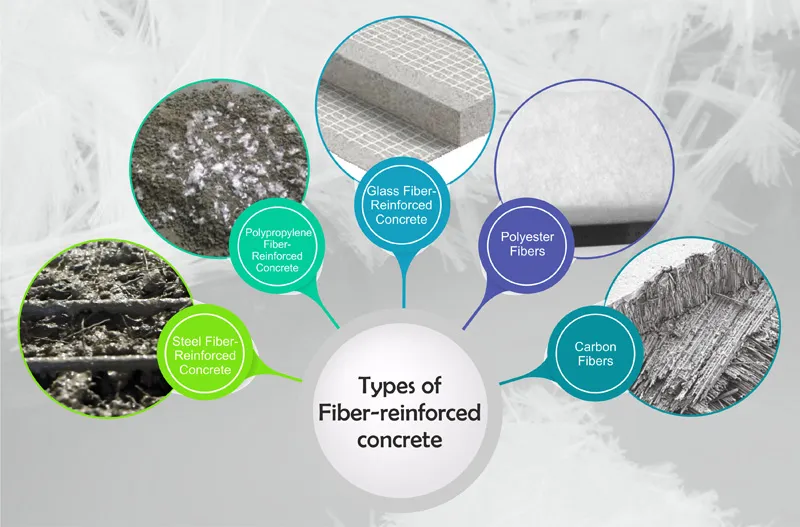
Different types of Fiber-reinforced concrete
Fibers for concrete are available in different sizes and shapes. The major factors affecting the characteristic of fiber-reinforced concrete are a water-cement ratio, percentage of fibers, diameter and length of fibers. Given below are different types of fiber-reinforced concrete used in construction.
Steel Fiber Reinforced Concrete
Steel fiber is a metal reinforcement. A certain amount of steel fiber in concrete can cause qualitative changes in concrete’s physical property. It can greatly increase resistance to cracking, impact, fatigue, and bending, tenacity, durability, and others. For improving long-term behavior, enhancing strength, toughness, and stress resistance, SFRC is being used in structures such as flooring, housing, precast, bridges, tunneling, heavy-duty pavement, and mining. The types of steel fibers are defined by ASTM A820 are, Type I: cold-drawn wire, Type II; cut sheet, Type III: melt-extracted, Type IV: mill cut and Type V: modified cold-drawn wire

Polypropylene Fiber Reinforced (PFR) Concrete
Polypropylene fiber reinforced concrete is also known as polypropene or PP. It is a synthetic fiber, transformed from propylene, and used in a variety of applications. These fibers are usually used in concrete to control cracking due to plastic shrinkage and drying shrinkage. They also reduce the permeability of concrete and thus reduce the bleeding of water. Polypropylene fiber belongs to the group of polyolefins and is partially crystalline and non-polar. It has similar properties as polyethylene, but it is harder and more heat resistant. It is a white rugged material with high chemical resistance. Polypropylene is manufactured from propylene gas in the presence of a catalyst such as titanium chloride. Polypropylene fiber displays good heat-insulating properties and is highly resistant to acids, alkalies, and organic solvents.
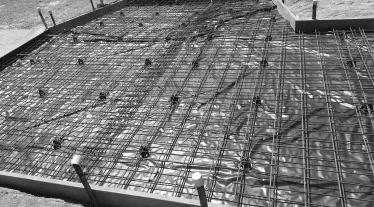
Glass Fiber Reinforced Concrete
Glass fiber reinforced concrete is a material consisting of numerous extremely fine fibers of glass. Glass fiber has roughly comparable mechanical properties to other fibers such as polymers and carbon fiber. Although not as rigid as carbon fiber, it is much cheaper and significantly less brittle when used in composites. Glass fibers are therefore used as a reinforcing agent for many polymer products; to form a very strong and relatively lightweight fiber-reinforced polymer (FRP) composite material called glass-reinforced plastic (GRP), also popularly known as “fiberglass”. This material contains little or no air or gas, is denser, and is a much poorer thermal insulator than is glass wool.
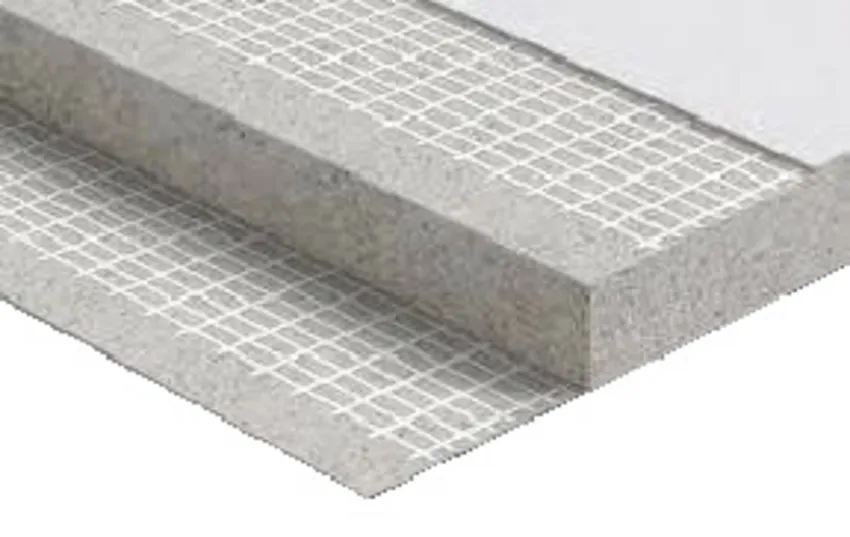
Polyester fibers
Polyester fibers are used in fiber-reinforced concrete for industrial and warehouse floors, pavements and overlays and precast products. Polyester micro- and macro-fibers are used in concrete to provide superior resistance to the formation of plastic shrinkage cracks versus welded wire fabric and to enhance toughness and the ability to deliver structural capacity when properly designed, respectively. Polyester micro- and macro-fibers are used in concrete to provide superior resistance to the formation of plastic shrinkage cracks versus welded wire fabric and to enhance toughness and the ability to deliver structural capacity when properly designed, respectively.
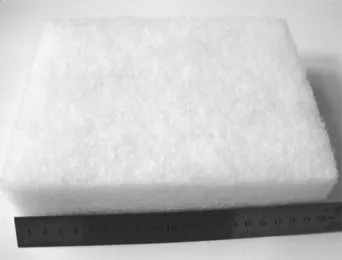
Carbon fibers
Carbon fibers are fibers about 5–10 micrometers in diameter and composed mostly of carbon atoms. Carbon fibers have several advantages including high stiffness, high tensile strength, low weight, high chemical resistance, high-temperature tolerance and low thermal expansion. Carbon fibers are usually combined with other materials to form a composite. When impregnated with a plastic resin and baked it forms carbon-fiber-reinforced polymer (often referred to as carbon fiber) which has a very high strength-to-weight ratio, and is extremely rigid although somewhat brittle. Carbon fibers are also composited with other materials, such as graphite, to form reinforced carbon composites, which have a very high heat tolerance.
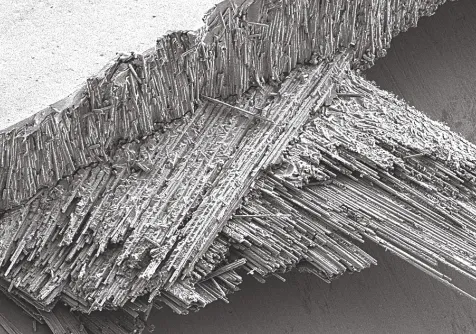
Macro synthetic fibers
Macro synthetic fibers are made from a blend of polymers and were originally developed to provide an alternative to steel fibers in some applications. Initially, they were identified as a potential alternative to steel fibers in sprayed concrete, but increasing research and development showed that they had a role to play in the design and construction of ground-supported slabs and a wide range of other applications. They are particularly suitable for providing nominal reinforcement in aggressive environments, such as marine and coastal structures, as they do not suffer the problems of staining and spalling that can result from the corrosion of steel. Besides, because they are non-conducting, they have been used in tram and light railway developments.

Micro-synthetic fibers
Micro-synthetic fibers provide superior resistance to the formation of plastic shrinkage cracks versus welded wire reinforcement, they are unable to provide any resistance to further crack width openings caused by drying shrinkage, structural load or other forms of stress. However, these products should be regularly specified in any type of concrete to improve cracking resistance, spall protection, freeze-thaw durability and improve the homogeneity of concrete during placement.
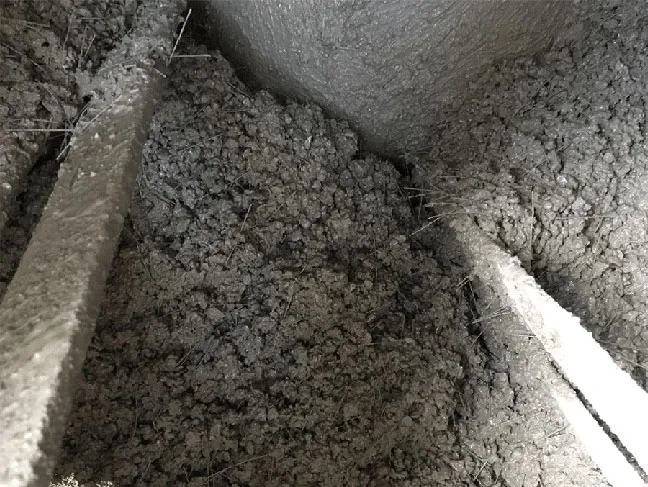
Natural fibers
The natural fiber is directly obtainable from an animal, vegetable, or mineral source and convertible into nonwoven fabrics such as felt or paper or, after spinning into yarns, into woven cloth. A natural fiber may be further defined as an agglomeration of cells in which the diameter is negligible in comparison with the length. Although nature abounds in fibrous materials, especially cellulosic types such as cotton, wood, grains, and straw. The use of natural fibers in making concrete is recommended since several types of these fibers are available locally and are plentiful. The idea of using such fibers to improve the strength and durability of brittle materials is not new; for example, straw and horsehair are used to make bricks and plaster. Natural fibers are suitable for reinforcing concrete and are easily available in developing countries.
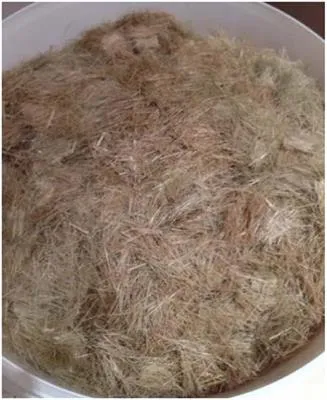
Cellulose fibers
Cellulose fibers are made with ethers or esters of cellulose, which can be obtained from the bark, wood or leaves of plants, or other plant-based material. In addition to cellulose, the fibers may also contain hemicellulose and lignin, with different percentages of these components altering the mechanical properties of the fibers. The main applications of cellulose fibers are in the textile industry, as chemical filters, and as fiber-reinforcement composites, due to their similar properties to engineered fibers, being another option for biocomposites and polymer composites.
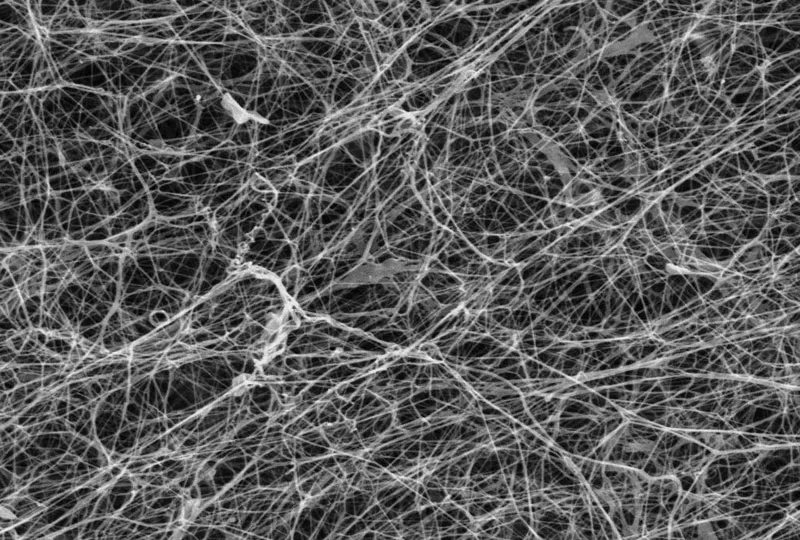
Application of Fiber-reinforced concrete
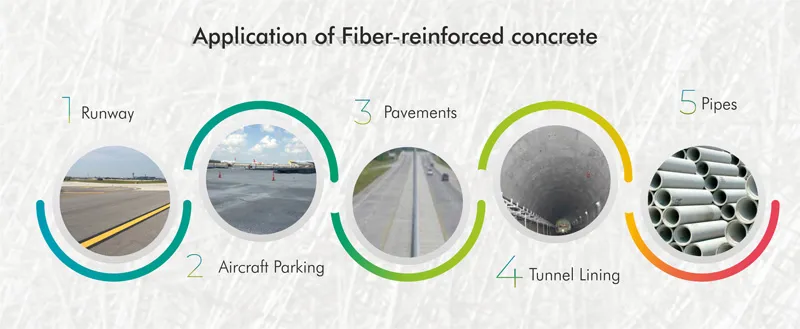
The applications of fiber reinforced concrete depend on the applicator and builder in taking advantage of the static and dynamic characteristics of the material. Some of its area of application is-
Runway
Aircraft Parking
Pavements
Tunnel Lining
Slope Stabilization
Thin Shell
Walls
Pipes
Manholes
Dams
Hydraulic Structure
Elevated decks
Roads
Bridges
Warehouse floors
Conclusion
Durability to aesthetics fiber-reinforced concrete can add benefits to your project. Fiber-reinforced concrete has been rapidly growing throughout the building industry since contractors and homeowners started to recognize its many benefits. Fibre Reinforced Concrete is gaining an increasing interest among the concrete community for the reduced construction time and labor costs. Besides cost issues, quality matters are of paramount importance for construction and fiber-reinforced concrete also fulfills these requirements.


